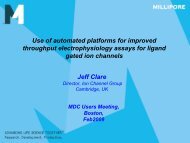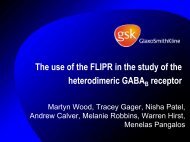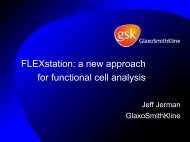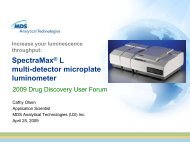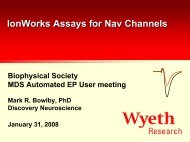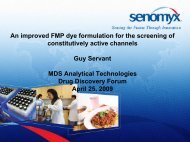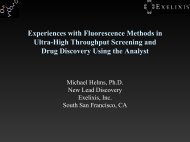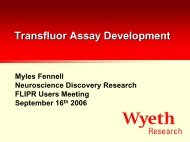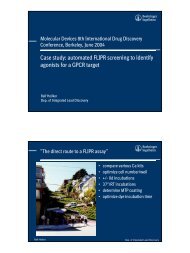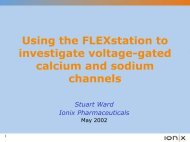â Realizing the potential of IonWorks screening in a drug discovery ...
â Realizing the potential of IonWorks screening in a drug discovery ...
â Realizing the potential of IonWorks screening in a drug discovery ...
You also want an ePaper? Increase the reach of your titles
YUMPU automatically turns print PDFs into web optimized ePapers that Google loves.
<strong>Realiz<strong>in</strong>g</strong> <strong>the</strong> <strong>potential</strong> <strong>of</strong> <strong>IonWorks</strong><strong>screen<strong>in</strong>g</strong> <strong>in</strong> a <strong>drug</strong> <strong>discovery</strong>environmentBenjam<strong>in</strong> Wilenk<strong>in</strong>Ion Channel GroupCNS BiologyPfizer GrotonMolecular Devices User Meet<strong>in</strong>gJanuary 2008
Outl<strong>in</strong>e• Ion channel <strong>drug</strong> <strong>discovery</strong> at Pfizer– Brief description <strong>of</strong> resources and team• Infrastructure– Hardware <strong>in</strong>vestment– <strong>IonWorks</strong> applications <strong>in</strong> a <strong>drug</strong> <strong>discovery</strong> environment• Case Study– Na v Assay• Challenges/Issues
Groton ion channel <strong>drug</strong> <strong>discovery</strong>CNS ion channel lab groupsGrotonAnn Arbor• Re-deployment from AA to Groton• Hardware upgrade to 48 channeldispens<strong>in</strong>g head and fluidics25 lab members
New technologies facilitate an <strong>in</strong>tegratedapproach to ion channel <strong>drug</strong> <strong>discovery</strong>Idea Lead development Candidate <strong>drug</strong>Throughput/capacity1000’s 100’s 10’s 1’s<strong>IonWorks</strong>(384)QPatch(48)Manual(1 – serial)FLIPR(384)OpusXpress(8)
Electrophysiology has an <strong>in</strong>tegralrole <strong>in</strong> iterative ion channel <strong>drug</strong> designDesignSYNTHESISFLIPRS<strong>in</strong>gle po<strong>in</strong>tIon channelmodulatorChemical spaceexpansionHT EPHYSElectrophysiologyIC 50 / use dependencyFLIPRretestIC 50• Functional ion channel <strong>screen<strong>in</strong>g</strong>not rate limit<strong>in</strong>g• Unique opportunity <strong>in</strong> ion channel<strong>drug</strong> <strong>discovery</strong>• HTS electrophysiology provides anideal tool to discern detailed SARDrugproperties
<strong>IonWorks</strong> application <strong>in</strong> <strong>drug</strong> <strong>discovery</strong>case study•Na v Assay– Cell husbandry and preparation– Assay format– Indices <strong>of</strong> efficacy– Target<strong>in</strong>g pathophysiological states– Facilitate lead compound selection
Assessment <strong>of</strong> cell growth parameters areparamount to maximize <strong>screen<strong>in</strong>g</strong> success• IncuCyte – networked, <strong>in</strong>cubator-based cell imag<strong>in</strong>ganalysis system– Elim<strong>in</strong>ates subjectivity– Characterizes growth k<strong>in</strong>etics– Characterizes most appropriate seed<strong>in</strong>g densities– Evaluate expression as a function <strong>of</strong> confluence– Key for consistency and experimental schedul<strong>in</strong>g
Cell passage and growth phase are an <strong>in</strong>tegralpart <strong>of</strong> assay designNa v Cell Confluence (%) vs Time (hrs)Passage 7150K cells/ml50K cells/mlPassage 17Seed<strong>in</strong>g densities <strong>in</strong>fluence cell growth ratesGrowth rates change over time with<strong>in</strong>creas<strong>in</strong>g cell passage3 hours – 10% Confluence 48 hours – 40% Confluence 72 hours – 70% Confluence
Growth k<strong>in</strong>etics dictate experimental tim<strong>in</strong>gThe optimal assay w<strong>in</strong>dow is def<strong>in</strong>ed by desired growth k<strong>in</strong>etics andexperimental tim<strong>in</strong>g
Cell preparation affects seal quality and currentamplitudeAverage Seal Resistance350~ 180 MΩ ~ 268 MΩSeal Resistance (MOhms)300250200150100Versene Prep<strong>IonWorks</strong> HT Experimental RunsVersene / Tryps<strong>in</strong> PrepAverage seal resistance is <strong>in</strong>creased when a50:50 tryps<strong>in</strong>/versene mix is used to lift <strong>the</strong> cellscompared to that <strong>of</strong> versene aloneAverage current amplitude is <strong>in</strong>creased when a50:50 AmphoB/Nystat<strong>in</strong> mix is used to as <strong>the</strong>perforat<strong>in</strong>g agent relative to just AmphoB
Variables <strong>in</strong>fluenc<strong>in</strong>g assay success• Cell husbandry and preparation– Cell Passage– Cell Density– Tryps<strong>in</strong>/versene cocktail to lift cells– Slow sp<strong>in</strong> prior to f<strong>in</strong>al suspension– Gentle trituration to break-up pellet prior toexperiment start* * * Gentle Gentle Gentle * * *• Compound preparation– Glass vials– Low-b<strong>in</strong>d<strong>in</strong>g compound plates– All dilutions made <strong>in</strong> DMSO
Assay format• S<strong>in</strong>gle hole HT mode• Pulse to -10mV from -55mV 25times @ 10Hz• First run <strong>of</strong> day from -100mV– Keep track <strong>of</strong> relative current– Provides estimate <strong>of</strong> voltagecontrol• 6 compounds/plate• Full 7-pt IC 50 ’s• One row vehicle control• Four plates/day – 24cmpds/day• 96 cmpds/week
The importance <strong>of</strong> voltage control on<strong>IonWorks</strong>Na v Inactivation~ 11mVThe steady-state <strong>in</strong>activation curve <strong>in</strong>dicates that an 11mV shift <strong>in</strong>voltage can yield a 50% shift <strong>in</strong> current amplitude.
Voltage-dependence <strong>of</strong> compound xpharmacologyCompound x IC 50vs. Hold<strong>in</strong>g Potential80706050IC 50(µM)403020100-50mV-55mVHold<strong>in</strong>g Potential (mV)-65mV•This figure demonstrates <strong>the</strong> voltage-dependence <strong>of</strong> compound xpharmacology.•Compound x pharmacology is used as a measure <strong>of</strong> voltage control <strong>in</strong>each day’s run
Sample ion channel record<strong>in</strong>gPre-compoundPost-compoundIC 50 (#1)Use-Dependency Ratio:IC 50 (#1) / IC 50 (#25)IC 50 (#25)
<strong>IonWorks</strong> can resolve differential pharmacology1 st Pulse Compound Concentration Response25 th Pulse Compound Concentration Response10010080Compound 1Compound 280Compound 1Compound 26060% Inhibition40200IC 50= 0.569µMIC 50= 121µM% Inhibition40200IC 50= 0.148µMIC 50= 50µM-20-20-400.01 0.1 1 10 100 1000Concentration (µM)0.01 0.1 1 10 100 1000 10000Concentration (µM)Two compounds with differential pharmacology, but similar use-dependency ratiosCompound 1 use-dependence ratio is 3.8Compound 2 use-dependence ratio is 2.5
Assay validation post-relocation• Run Patch Plate Tests– Verify overall operationalcapability• Run basic cell plates– Verify seal rates, sealvalues and current are onpar• Run protocol withreference agents– Verify IC 50 values haven’tdrifted
What happened?• Run protocol withreference agents– Verify IC 50 valueshaven’t drifted-- Compound IC 50 values shifted from historical-- cell-cell variability unacceptably high-- run-down/run-up outside <strong>of</strong> allowable limits (± 5%)
Resolution approachRe-chlorideE-headThaw new cellsSteps takento mitigateissuesLiaise with MDCObta<strong>in</strong>freshreagentsPreparefreshsolutions
Fur<strong>the</strong>r <strong>in</strong>vestigations…• Current-Voltage relationship•V 1/2 Inactivation• Quantify current drift (run-up/run-down)when compar<strong>in</strong>g pre & post
I-V and <strong>in</strong>activation curvesre-visited…1.2Normalized Current-Voltage Relationship0.2Normalized Current-Voltage RelationshipVoltage (mV)1.21.21.01.0Na v InactivationNa v InactivationNormalized Current Value1.00.80.60.40.20.0-70 -60 -50 -40 -30 -20 -10 10 20-0.2Peak = -10mVn=7Normalized Current Value-70 -60 -50 -40 -30 -20 -10 0 10 20Voltage (mV)-0.4-0.6-0.8-1.0-1.2Inactivation0.80.80.60.60.40.40.20.20.00.0-0.2-0.2V 1/2 Inactivation = -55mV ± 0.36V 1/2 Inactivation = -55mV ± 0.36n=7-100 -80 -60 -40 -20 0-100 -80 -60 -40 -20 0Voltage (mV)Voltage (mV)The current-voltage and steady-state <strong>in</strong>activation relationships are shown here. Peak <strong>in</strong> <strong>the</strong> I-Vcurve is -10mV and <strong>the</strong> v 1/2 <strong>of</strong> <strong>in</strong>activation is -55mV.
Voltage control?• Look at repetitive scans with multiple additionsCurrent - Voltage RelationshipVoltage (mV)-70 -60 -50 -40 -30 -20 -10 10 20no addition1st buffer addition2nd buffer addition-0.5-1.0Current (nA)-1.5-2.0-2.5Peak run-downThe figure here represents <strong>the</strong> current-voltage relationships follow<strong>in</strong>g multiple additions <strong>of</strong> buffersolution
Pre- to post-addition current amplitudechanges12005.12.06 Na vChip 1 -55mV to 005.12.06 Na vChip 2 -100mV to 011.27.07 Na vChip 1 -55mV to -10mV11.27.07 Na vChip 2 -100mV to -10mV7010060Cell Number8060402000-56-1011-1516-2021-2526-3031-35Pre - Post Current Change (%)36-4041-4546-5051-5556-6061-6566-7071-7576-8081-8586-9091-9596-100Cell Number504030201000-56-1011-1516-2021-2526-3031-35Pre - Post Current Change (%)36-4041-4546-5051-5556-6061-6566-7071-7576-8081-8586-9091-9596-100The histograms here depict <strong>the</strong> trend <strong>in</strong> current amplitude change (absolute change) that is seenwhen compar<strong>in</strong>g current record<strong>in</strong>gs prior to and follow<strong>in</strong>g a s<strong>in</strong>gle buffer addition. Record<strong>in</strong>gs wereobta<strong>in</strong>ed from hold<strong>in</strong>g <strong>potential</strong>s <strong>of</strong> ei<strong>the</strong>r -55mV or -100mV.
Where we go from here…• Is this a cell l<strong>in</strong>e and/or hardware issue?– Assess alternate Na v cell l<strong>in</strong>e–Na v cell l<strong>in</strong>e on alternate platform– 12 vs. 48 channel dispense head?• Does a PPC mode assay reduce variability?• Re-clone cell l<strong>in</strong>e <strong>in</strong> CHO background• Shorten pulse tra<strong>in</strong> length and frequency• Cont<strong>in</strong>ue to liaise with MDC
Summary• Cell l<strong>in</strong>e husbandry and detailed characterization <strong>of</strong>growth parameters are critical to maximiz<strong>in</strong>g success• <strong>IonWorks</strong> is an <strong>in</strong>tegral part <strong>of</strong> a coord<strong>in</strong>ated ionchannel <strong>drug</strong> <strong>discovery</strong> paradigm– Rapid SAR analysis and compound attrition– Ability to support high-speed chemistry approaches– Additive and complementary to optical approaches• Functional pharmacological data can be obta<strong>in</strong>edrapidly to aid <strong>in</strong> optimal candidate <strong>drug</strong> identification– Provides a means to identify compounds targeted to diseaserelevantion channel states
Acknowledgements• Peter Haddock• Chris Benjam<strong>in</strong>• Mark Weber• Jim Offord• Walt Volberg• Joe Ma<strong>the</strong>r• Kev<strong>in</strong> Allard• Jim Costant<strong>in</strong>•Richard Kondo
Back-up slides
<strong>IonWorks</strong> application <strong>in</strong> <strong>drug</strong> <strong>discovery</strong> casestudy #2Kv assay format• HT & PPC modes• 50:50Tryps<strong>in</strong>/Versene mixto lift cells• Amphoteric<strong>in</strong> B toga<strong>in</strong> access• Pulse to -20mV from-80mV for 3 sec.
Kv70S<strong>in</strong>gle hole mode70Population patch mode606030μM retagab<strong>in</strong>econtrol5050Cell count40304030controlactivation10μM XE991<strong>in</strong>hibition20200.2nA0.2nA10102s2s000.0 0.2 0.4 0.6 0.8 1.0 1.2 0.0 0.2 0.4 0.6 0.8 1.0 1.2Kv current (nA)Population patch mode assay <strong>in</strong>creases datafidelity and throughput 4x<strong>IonWorks</strong> assay can identify activators and <strong>in</strong>hibitors
Correlations between FLIPR and <strong>IonWorks</strong> aid<strong>in</strong> advanc<strong>in</strong>g <strong>drug</strong> candidacyFLIPR vs. <strong>IonWorks</strong> Correlation100FLIPR Na vIC 50(μM)1010.1 1 10 100<strong>IonWorks</strong> Na v25 th Pulse IC 50(μM)The strong correlation between <strong>the</strong> two platforms contributes support to <strong>the</strong> SARthat drives <strong>screen<strong>in</strong>g</strong> and project advancement.



